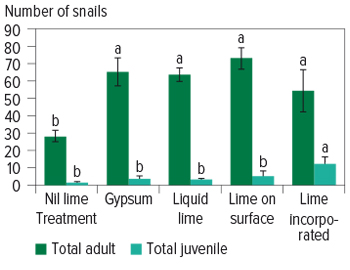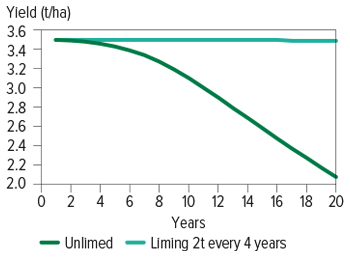Key points
- Snail numbers can increase after liming. While this adds work with snail control, it is best to keep liming and budget for snail management. The cost of acidifying soil will eventually be greater than the cost of snail management.
- Any calcium source (for example, lime, gypsum, dead snails) can be a calcium source for snails.
Some growers have noticed snail numbers increase after liming. Lime is a source of calcium which increases shell strength and fertility.
Off the back of this observation, a small research trial was conducted to gauge the impact liming had on snail fertility and shell strength, and whether incorporating lime or using a different type of lime could limit snail population growth.
Using an acidic soil (pH 4.8 in CaCl2) from South Stirling in WA, the trial compared:
- gypsum (2.7 tonnes per hectare) applied to the soil surface;
- liquid lime (100 litres/ha) applied to the soil surface;
- limestone (2t/ha) applied to the soil surface; and
- limestone (2t/ha) incorporated into the soil.
Calcium increases snail numbers
Both the gypsum (also a source of calcium) and lime increased snail numbers compared to the control. Surface lime led to marginally higher adult snail numbers than other treatments, but there was no significant difference in snail numbers between calcium sources.
All treatments (except incorporated limestone) increased juvenile numbers compared to the control, but not significantly.
Incorporating versus surface lime
Incorporated lime had the lowest number of adult snails, but the results were not significantly different. However, incorporating lime produced significantly more juveniles (Figure 1). This is likely because incorporating lime into the acidic soil led to better plant growth and therefore food sources for the snails.

Figure 1. Average number of juvenile and adult snails ± SEM (standard error of the mean) in the five different treatments. Letters indicate significant differences (P<0.05) within categories (adult or juvenile). Source: S Micic, DPIRD, "Improving slug and snail efficiency of slug and snail control".
Limestone increased shell strength
Snails with access to limestone had stronger shells. This was evident in the incorporated lime treatment as well as the surface lime, as there was enough lime left on the surface for the snails to use.

Figure 2. Shell strength of adults and juveniles exposed to different liming treatments ± SEM (standard error of the mean). Letters indicate significant differences (P<0.05).Source: S Micic, DPIRD, "Improving slug and snail efficiency of slug and snail control".
Consequences of not liming
As cropping is an acidifying activity, stopping or reducing liming will lead to ongoing soil acidification, yield penalties, and greater future costs to get pH back into the desirable range. In the long term, regular lime applications to acidity-prone soils are important to both neutralise the acidity that is generated each year and to protect subsurface soils from acidity.
Figures 3 and 4 show ongoing soil pH and yield decline when liming stops. The data has been derived from iLime, using a continuous wheat rotation for simplicity. Without liming to counter ongoing acidification, yield continually drops, leading to an 11 per cent yield penalty after 10 years and a 41 per cent penalty after 20 years. Maintenance liming, 2t/ha every four years, maintains yield.

Figure 3. Yield decline in a sandy earth with a marginal pH profile (starting pHCaCl2 5.3 in topsoil, 4.6 in subsoil). Source: S. Micic et al, 2020.
Liming (2 tonnes every four years) marginally improves pH in the top 20 centimetres (Figure 4). Without liming, soil pH drops annually, down to 4.3 after 10 years. Aluminium toxicity, affecting root development and ultimately yields, is an issue for most crops once soil pH starts to get less than 5.0 in CaCl2.

Figure 4. Soil pH changes in 20cm of limed vs unlimed soil. Source: S Micic et al, 2020.
Managing liming and snails together
Where snails are a concern, have a monitoring and management strategy in place to deal with potential snail increases after liming. Snails lay their eggs around late summer and autumn, when there is some soil moisture.
Baiting
As liming tends to take place in summer, growers might lime as usual then bait when conditions are right. The best time to bait is in autumn (late March to April), after a rainfall event when snails are actively moving and feeding. Aim to kill snails before they lay their eggs. If this window is missed, snails will lay eggs and remain a problem in following years.
Stubble management
Round snails tend to move off the ground in summer when the ground is hot, on to anything they can find such as stubble, fence posts and tree trunks. Flattening and chopping stubble with a stubble cruncher or roller puts snails on the ground and can kill them before they start breeding if it is done on hot days (more than 35 degrees Celsius). Stubble management to control snails must be balanced with any potential risks of erosion.
Knocking snails to the ground after liming should not increase the snail risk (by putting them closer to a calcium source), as live snails move up and down off the ground anyway.
Flattening stubble is not very effective on small conical (pointed) snails as they burrow inside crop stems, under stubble and in root balls.
Sow cereals after liming
Juvenile snails are a greater contamination risk in canola. Sowing cereals in the year after liming can lower the contamination risk.
Stubble burning
Stubble burning can be an effective control method. Stubble does not burn hot enough to affect the lime. However, burning leaves paddocks more exposed to wind erosion which can remove finer line from the soil surface.
Anecdotal evidence suggests that burning suppresses snail numbers for about four years. Baiting will keep numbers down in the following years, providing it is done at the right time to break the snail life cycle (before they lay eggs).
If the plan is to have full stubble retention in the year after burning, budget to bait more than once in that following season.
More information on snail management is in Bash’Em Burn’Em Bait’Em.
Conclusion
Ongoing snail management is essential in areas with snail problems. Consider snail management just another step in the liming process.
It is not possible to completely eradicate snails and stopping liming will cause a compounding series of problems and declining yields.
Acknowledgements
Svetlana Micic, DPIRD. Kym Perry, SARDI.
References and further reading
Micic S, Skinner G, Dore T, Babativa-Rodriguez C. 2020. Determining the effect of lime on small pointed (conical) snail fecundity and shell strength, DPIRD.
SARDI. 2003. Bash’Em Burn’Em Bait’Em.

























































